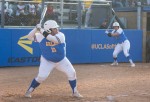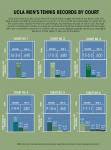This Week in the News serves as The Quad’s space for reflection on current events at and around UCLA. Every week, Daily Bruin staffers will analyze some of the most significant stories to keep readers up to speed.
Marc Kalis, a fourth-year statistics student, has gone missing.
Kalis was last seen moving out of Sproul Hall about two weeks ago, where he previously worked as a resident assistant.
Kalis was born in Cape Town, South Africa, but grew up in Bahrain. His parents have come to Los Angeles to aid in the search and will remain in the country until he is found.
UCPD has said there have been no new developments in the case since Kalis was reported missing.
Anyone with information about the case can contact UCPD at 310-825-1491 or Kalis’ parents at 424-391-4387.
Three former football players allege neglect and severe injury, sue Jim Mora, UCLA
Former UCLA football players John Lopez, Poasi Moala and Zachary Bateman filed lawsuits against UCLA, former head coach Jim Mora and the NCAA on Thursday.
The lawsuits allege that while playing at UCLA, Mora and his coaching staff repeatedly neglected the players’ injuries and rushed them back to the field too early.
Lopez, who filed a $15 million lawsuit, alleges that he suffered three traumatic brain injuries during his time playing for the Bruins that played a significant role in eventually causing his 2016 suicide attempt, according to Thakur Law Firm, APC.
Moala, according to the firm, also alleges that concussions as well as hip injuries he sustained while playing for UCLA led to symptoms of traumatic brain injury. Similarly, Bateman is suing Mora and the school for severe foot injuries sustained while playing for the Bruins that were allegedly worsened due to neglect, the firm said.
A UCLA statement released Thursday said the health and safety of student-athletes is the university’s top priority and that only team physicians are responsible for clearing injured players to play.
No. 2 seed UCLA softball defeated James Madison by a score of 7-2 on Saturday to advance to the Women’s College World Series in Oklahoma City as one of the final eight teams left in the postseason.
On Thursday, the Bruins defeated No. 7 seed Minnesota by the same score of 7-2 in the opening round of the world series.
Junior outfielder Bubba Nickles hit a lead-off home run for UCLA, and redshirt junior pitcher Rachel Garcia pitched a complete game, giving up just two runs on four hits while striking out seven.
UCLA advanced to the winners bracket where it will face No. 6 seed Arizona on Friday afternoon.
UCLA community offers views on possibilities, shortcomings of SAT ‘adversity score’
The College Board recently announced a new Environmental Context Dashboard –referred to as an “adversity score” by many media outlets. The score aims to provide context to student’s socio-economic and education backgrounds to supplement their SAT scores.
The Daily Bruin asked several UCLA professors and students whether they thought the new score would be effective in increasing disadvantaged students’ access to higher education.
Tyrone Howard, an education professor at UCLA, was concerned the ECD does not factor in race to a student’s education and background.
Similarly, Naomi Riley, a second-year political science student and the Academic Affairs commissioner for the Undergraduate Students Association Council, said she doesn’t think the ECD will help disadvantaged peoples in the ways the College Board thinks it will.
“I think the push towards the adversity score is kind of like standardizing and categorizing struggle, which I think is problematic in itself,” Riley said in the article published Tuesday. “And I think it really generalizes people’s personal history and struggle and things of that nature.”
Ozan Jaquette, an assistant professor in higher education at UCLA who was consulted on the creation of the ECD, said he thinks the implementation of the ECD is a step in the right direction but that it may become more effective once it undergoes further adjustments.
33rd JazzReggae Fest brings community together to celebrate music under the sun
Attendees at the JazzReggae Festival held Monday at Sunset Recreation Center saw seven different musical talents perform.
In the 33rd iteration of the event, performers ranged from The Roswell Universe, who described its music as “International Space Music,” to Etana, a Jamaican reggae singer who recently received a Grammy nomination for her album “Reggae Forever.”
Two jazz groups from the UCLA Herb Alpert School of Music also performed. The larger UCLA Contemporary Jazz Ensemble performed a variety of traditional-sounding jazz numbers, while the ensemble from the Herbie Hancock Institute of Jazz Performance at UCLA was smaller and featured more freestyle solos.
Attendees soaked up the music and the sun while mostly laying out on blankets.
Nosalina Joane Omorogieva, co-director of the JazzReggae Fest, came on stage before McGregor to thank the performers, security, staff and volunteers for helping to put on the event, and the audience for coming out on a hot and sunny day.
Students voice concerns about bathroom policy, security camera monitoring
Students at a town hall Tuesday voiced their concerns over two recently drafted policies.
UCLA Policy 890, Gender Inclusive Facilities, will require all new campus buildings to have at least one multistall gender-inclusive bathroom within the building or at least two bathrooms within a two-minute walk.
Student feedback regarding Policy 890 focused on the requisite height partitions between stalls, which were stipulated to be higher than the typical partitions found in male or female restrooms. Some students saw the taller partitions as transphobic while others pointed out how they could drive up renovation costs enough to inhibit the quick construction of multistall gender inclusive restrooms.
Policy 133, Security Camera Systems, aims to create a centralized database of recorded images and establish guidelines for the removal of cameras that are not compliant with the new policy. Student concerns regarding Policy 133 centered on the possibility for racial profiling in live camera monitoring.
Administrative Vice Chancellor Michael Beck said that there are currently 2,500 cameras on campus not regulated by a single policy and that Policy 133 aims to unify regulations on campus security cameras and remove those that do not apply.
After the review periods for both policies ends June 20, administrators will have the chance to propose more revisions based on student input.






